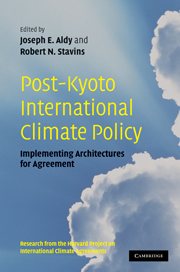Book contents
- Frontmatter
- Contents
- Harvard Environmental Economics Program, International Advisory Board
- Harvard Project on International Climate Agreements, Faculty Steering Committee
- Harvard Project on International Climate Agreements, Project Management
- List of figures
- List of tables
- List of contributors
- Foreword
- 1 Introduction
- Part I Alternative international policy architectures
- 2 An elaborated proposal for a global climate policy architecture: specific formulas and emission targets for all countries in all decades
- 3 The EU emission trading scheme: a prototype global system?
- 4 Linkage of tradable permit systems in international climate policy architecture
- 5 The case for charges on greenhouse gas emissions
- 6 Towards a global compact for managing climate change
- 7 Sectoral approaches to a post-Kyoto international climate policy framework
- 8 A portfolio system of climate treaties
- Part II Negotiation, assessment, and compliance
- Part III The role and means of technology transfer
- Part IV Global climate policy and international trade
- Part V Economic development, adaptation, and deforestation
- Part VI Modeling impacts of alternative allocations of responsibility
- Part VII Synthesis and conclusion
- Appendix A Selected List of Individuals Consulted, Harvard Project on International Climate Agreements
- Appendix B Workshops and Conferences, Harvard Project on International Climate Agreements
- Glossary and Abbreviations
- Index
4 - Linkage of tradable permit systems in international climate policy architecture
Published online by Cambridge University Press: 05 June 2012
- Frontmatter
- Contents
- Harvard Environmental Economics Program, International Advisory Board
- Harvard Project on International Climate Agreements, Faculty Steering Committee
- Harvard Project on International Climate Agreements, Project Management
- List of figures
- List of tables
- List of contributors
- Foreword
- 1 Introduction
- Part I Alternative international policy architectures
- 2 An elaborated proposal for a global climate policy architecture: specific formulas and emission targets for all countries in all decades
- 3 The EU emission trading scheme: a prototype global system?
- 4 Linkage of tradable permit systems in international climate policy architecture
- 5 The case for charges on greenhouse gas emissions
- 6 Towards a global compact for managing climate change
- 7 Sectoral approaches to a post-Kyoto international climate policy framework
- 8 A portfolio system of climate treaties
- Part II Negotiation, assessment, and compliance
- Part III The role and means of technology transfer
- Part IV Global climate policy and international trade
- Part V Economic development, adaptation, and deforestation
- Part VI Modeling impacts of alternative allocations of responsibility
- Part VII Synthesis and conclusion
- Appendix A Selected List of Individuals Consulted, Harvard Project on International Climate Agreements
- Appendix B Workshops and Conferences, Harvard Project on International Climate Agreements
- Glossary and Abbreviations
- Index
Summary
As the nations of the world consider alternative international climate policy architectures for the post-2012 period, tradable permit systems are emerging as a preferred domestic instrument for reducing greenhouse gas (GHG) emissions. The two most significant institutions for reducing GHG emissions implemented to date—the European Union Emission Trading Scheme (EU ETS) and the Clean Development Mechanism (CDM)—are tradable permit systems. Furthermore, tradable permit systems are being considered as the primary policy instrument for reducing GHG emissions in Australia, Canada, Japan, and the United States, among other countries.
Due to the increasingly likely prospect of a world with multiple tradable permit systems, attention has focused on how and whether to link these systems. Linking occurs when regulated entities in one tradable permit system are allowed to use emission allowances or emission reduction credits from another system to meet their domestic compliance obligations. These entities can then take advantage of cost savings from international trade: just as allowance trading within a tradable permit system allows higher-cost emission reductions to be replaced by lower-cost reductions within that system, trading across systems allows higher-cost reductions to be replaced by lower-cost reductions from a different system. These cost savings create significant incentives for regulatory authorities to link tradable permit systems.
Despite the benefits of linkage, there are also legitimate concerns about the implications of some linkages. These concerns depend, in part, on the type of linkage involved. One concern is that directly linking two cap-and-trade systems will result in the complete and automatic propagation of cost-containment measures from one system to the other.
- Type
- Chapter
- Information
- Post-Kyoto International Climate PolicyImplementing Architectures for Agreement, pp. 119 - 150Publisher: Cambridge University PressPrint publication year: 2009
- 4
- Cited by



